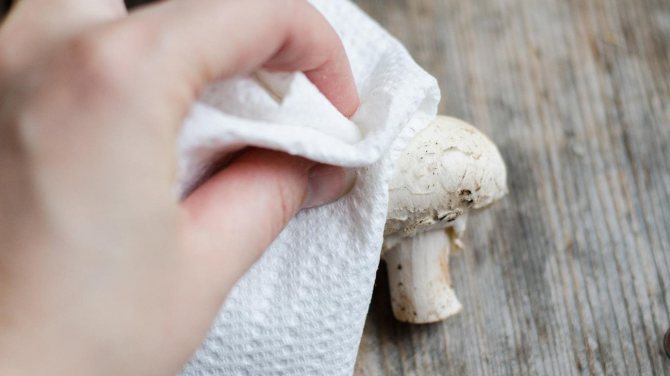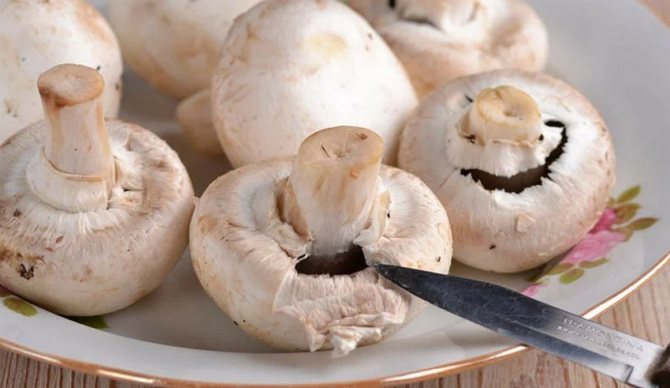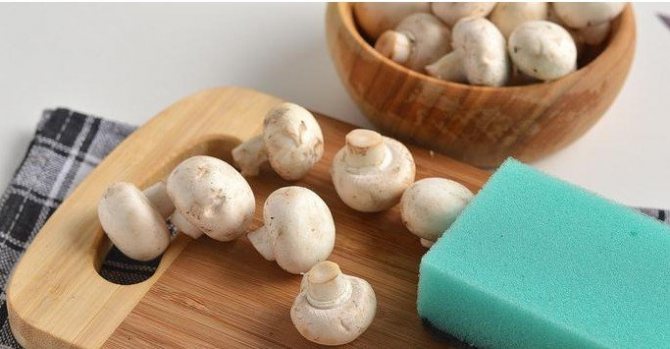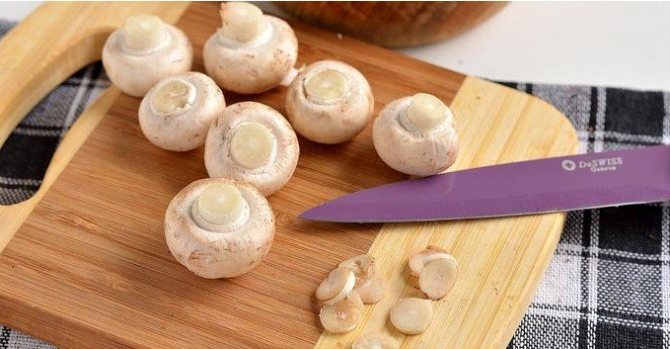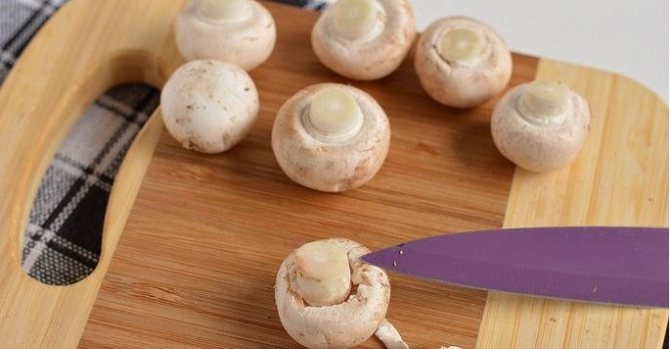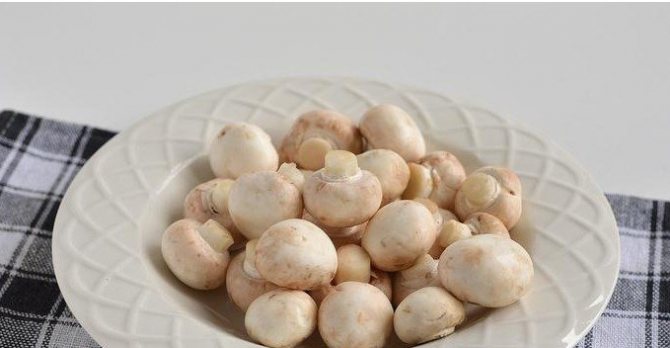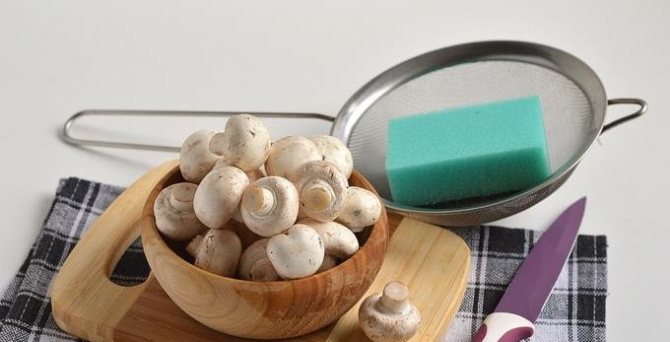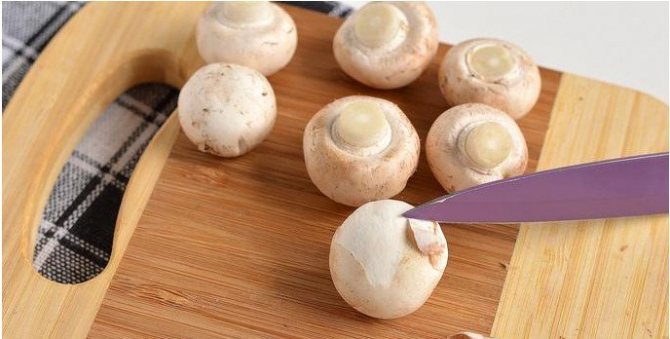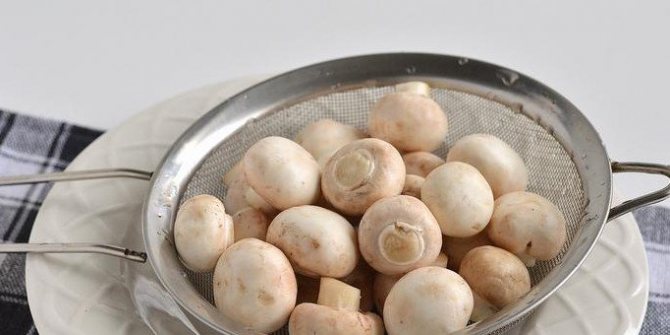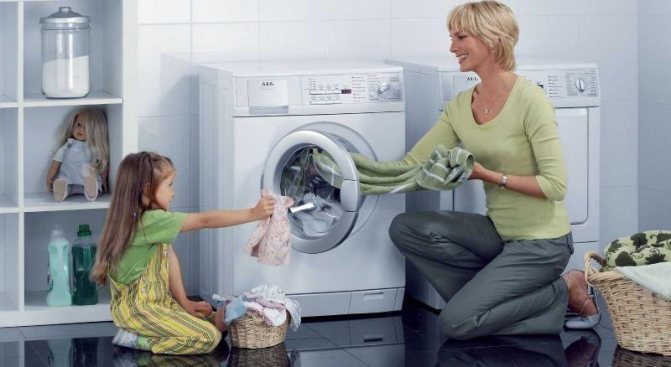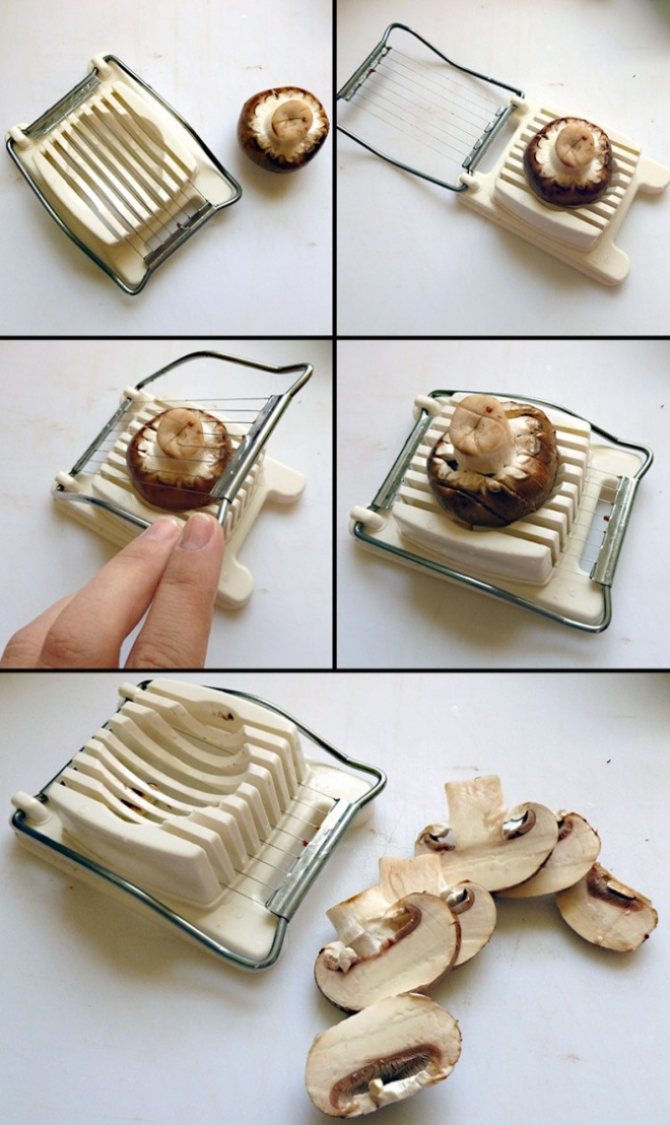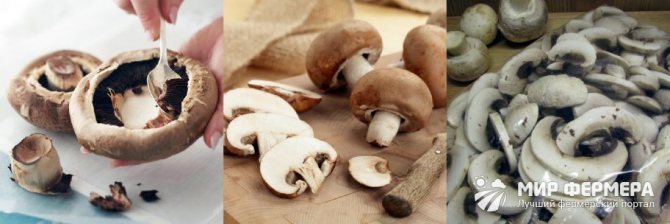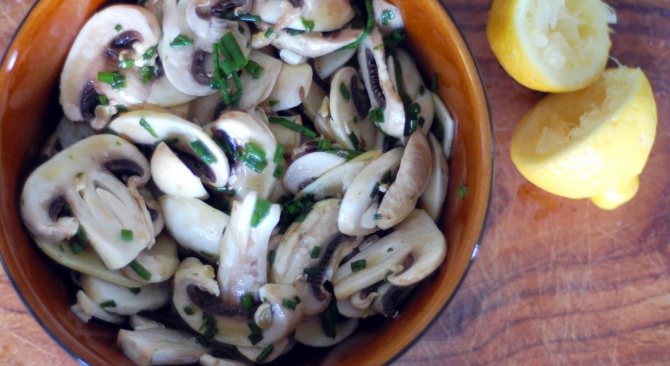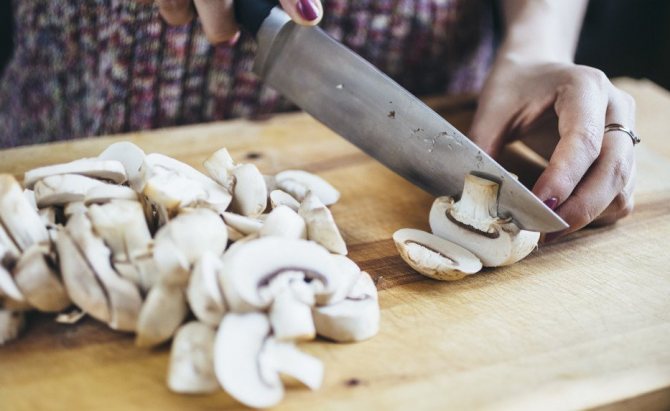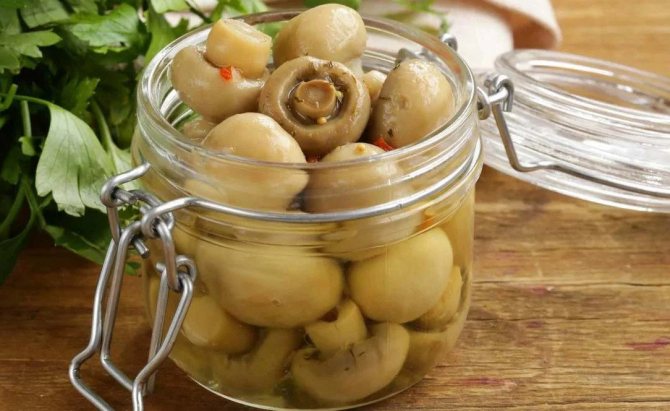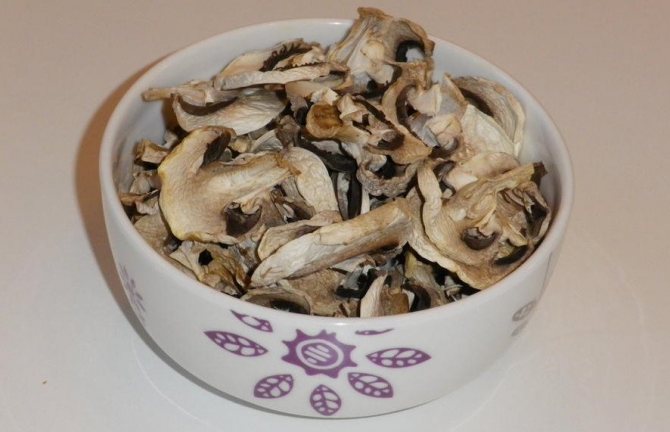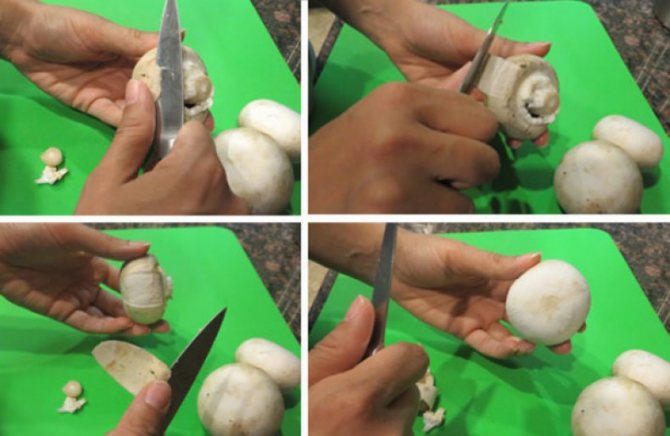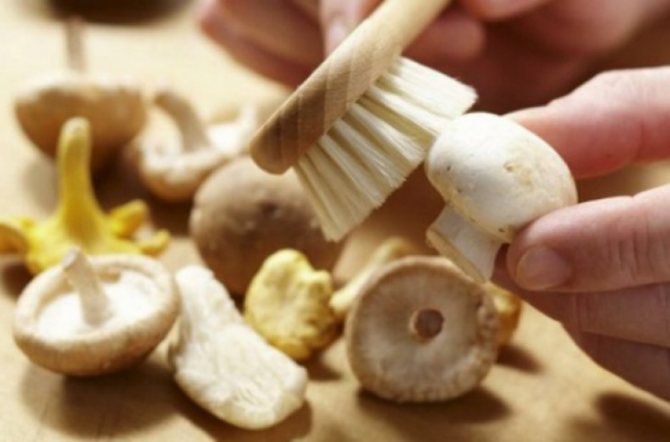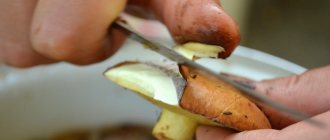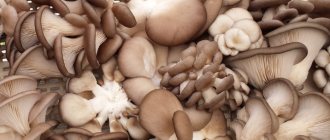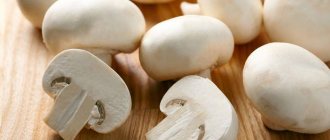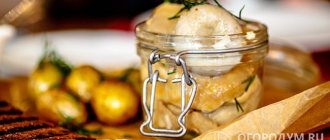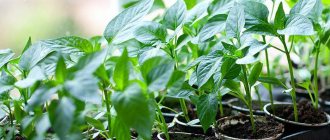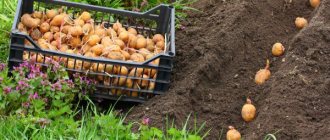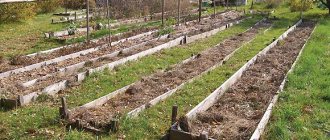Many people like such healthy and tasty mushrooms like champignons. It is especially good that they can be collected with your own hands in forest glades. Or they can be purchased in stores where they are in plain sight. So beautiful, fresh and clean, delivered straight from the greenhouse. Therefore, the question of whether it is necessary to clean the mushrooms from the store is of interest to many chefs. There are no special questions about the mushrooms that were collected in the forest, since they need to be cleaned of soil, small insects, blades of grass and needles, and then washed. But I want to start cooking the greenhouse harvest right away. In addition, some people eat clean and flavorful mushrooms raw. But in order not to harm your health, you need to do everything right before further preparations.

These mushrooms are worth peeling
Are champignons peeled
It is definitely not a question not to answer, in almost every recipe the author gives his thoughts and recommendations. Often they come down to the selection of mushrooms by size, after which they come to a decision: whether it is necessary to peel the mushrooms, or it is enough to do with a simple rinsing.
The most typical procedure is as follows: large and slightly damaged mushrooms are cleaned without fail, and for small ones there are selection criteria. So, champignons, the caps of which are less than three centimeters in diameter, are usually left unpeeled, and for large sizes, cleaning is done at the discretion of the cook.
Before washing mushrooms, which have dark spots and cracks on the surface, they are cut off from damage. Then they rinse and begin to remove the skin from the cap of the mushrooms. Their legs, as a rule, are scraped and the cut is renewed, removing 2-4 millimeters of pulp.
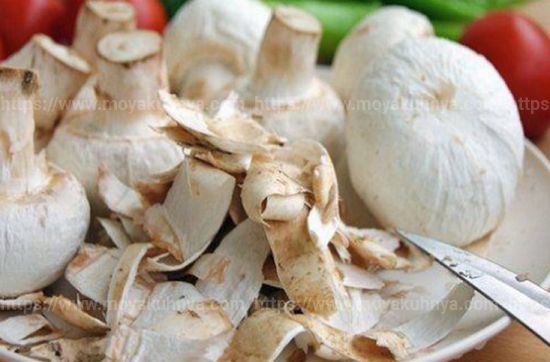

There is no fundamental difference between how to clean the mushrooms fresh from the store and those collected in nature, except that the "wild" mushrooms should be washed more thoroughly and inspected for damage. Champignons harvested in natural conditions should be approached with more stringent selection criteria. It is unacceptable to leave even small stains of unknown origin.
Do you need to peel the mushrooms before cooking, or is it better to do it immediately after harvesting? This question is generally incorrect. The faster you cook the mushrooms, the better in all respects, therefore, having collected the cherished basket of gifts of nature, immediately proceed to their preparation.
Before properly cleaning the mushrooms, we will certainly clean them of dirt. It is convenient to do this with a damp cloth, but in some cases you will need to use a soft sponge. Do not rub the caps and legs too hard if you unambiguously decide to remove the skin from the mushrooms, you just need to get rid of soil particles.
Next, we get the mushrooms wet from moisture, if they had to be heavily moistened in the process. Sometimes the dirt does not lag behind without soaking, but this should be done very carefully, not allowing the mushrooms to absorb excess moisture.
Duration of soaking - up to a quarter of an hour, do not feel sorry for water, it is worth stirring the mushrooms in it several times, and rub the well-visible dirt with your fingers or a sponge.The water temperature should be moderate, and after soaking the mushrooms, be sure to rinse, wipe off with a rag and rinse again.
It is not uncommon to recommend that forest (steppe) mushrooms be lightly boiled in salted water before cooking, is it necessary to peel the mushrooms before or after that? Heat treatment is not directly related to cleaning. Welding is performed, as a rule, after the skin is removed. Otherwise, it partially loses its meaning.
And wash or boil mushrooms?
Do I need to cook champignons? Most mushrooms cannot be washed or boiled by draining the water several times. But champignons are the opposite. Of course, you can argue, because mushrooms are such an unpredictable product, how can you use it if you don't boil it?
The fact is that champignons absorb water well, and they do it very quickly, which can negatively affect your dish. And from cooking, mushrooms can completely lose their taste, giving their qualities to mushroom broth.
Of course, it is imperative to rinse the mushrooms, you never know what chemicals could settle on them, but you should not soak and boil them.
It is better to rinse the mushrooms and quickly put them on a dry towel, so you will not spoil the taste of the mushrooms, and, if possible, clean them from dirt.
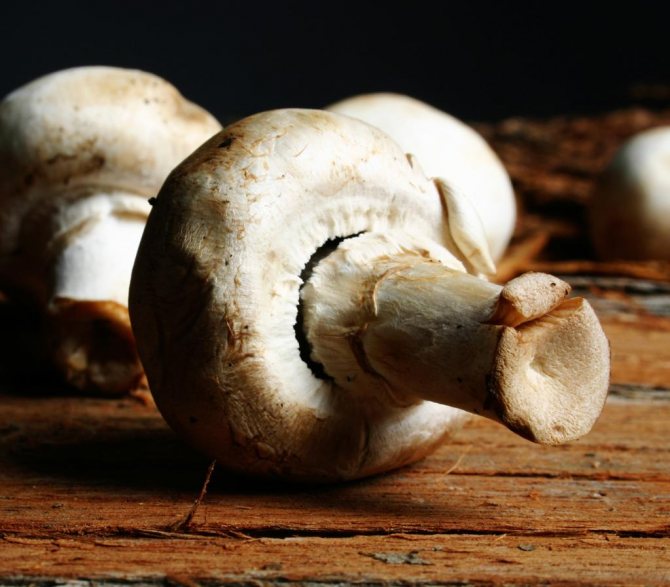

Do I need to peel the mushrooms and how to do it correctly
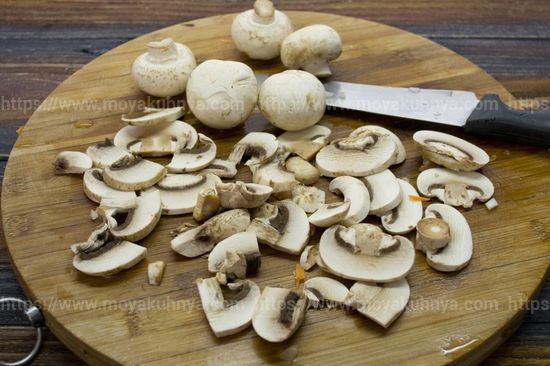

There are several ways of cleaning, although the process itself is rather unsophisticated - we use a knife, removing the outer skin. Do I need to peel the whole mushrooms or is it worth taking them apart first? If, according to the recipe, you do not need to cut the caps together with the legs, it is better to separate the latter even before cleaning, later you will save a lot of time.
Next, carefully cut the skin on the cap and, grabbing it between the knife blade and thumb, remove it, trying to grab a larger piece. Do not grind, intercept the skin often, it is much more convenient.
We have already mentioned that before peeling mushrooms, they are often soaked before cooking. By proceeding directly to peeling the skin, you will immediately understand why it should be done extremely quickly. The softened skin will tear, and the mushrooms themselves will be filled with moisture. In addition to the inconvenience, this will also affect the taste of the treat.
How to clean the mushrooms before cooking - whole or just the caps? Here, the criteria do not change, if the mushrooms are large or collected for a long time and began to darken, we clean them as diligently as possible. The peel from the inside of the cap is removed quite simply, if you have already started cleaning the mushrooms, you should not leave it.
A separate case is the preparation of mushrooms for long-term storage. If the choice fell on champignons, how to peel and how much to cook before freezing? Removing the skin is mandatory in this case. After storage frozen, with subsequent thawing and heat treatment, the skin often peels off. Not only is it not aesthetically pleasing, pieces of different density will come across in the dish, and this will spoil the taste.
Photo gallery: external differences between different types of champignons
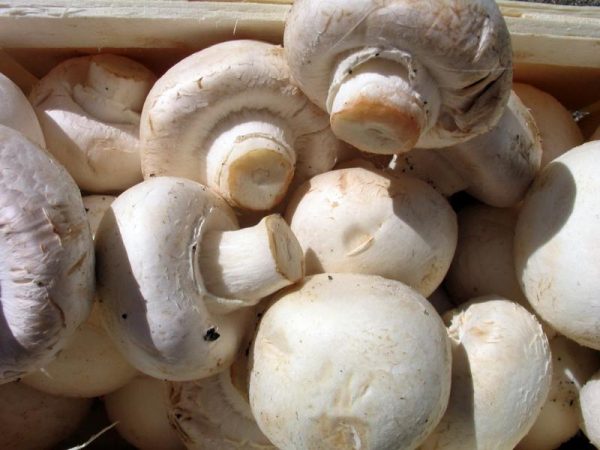

Common champignons are large, with large caps, matte white or pinkish
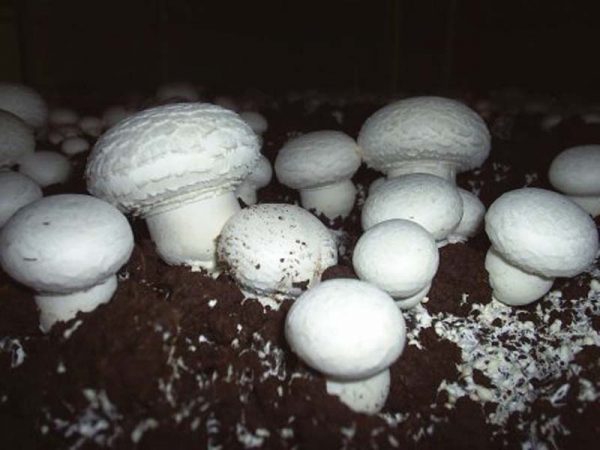

Garden mushrooms are usually slightly smaller than other mushrooms


This variety stands out for its pink cap and long stem.
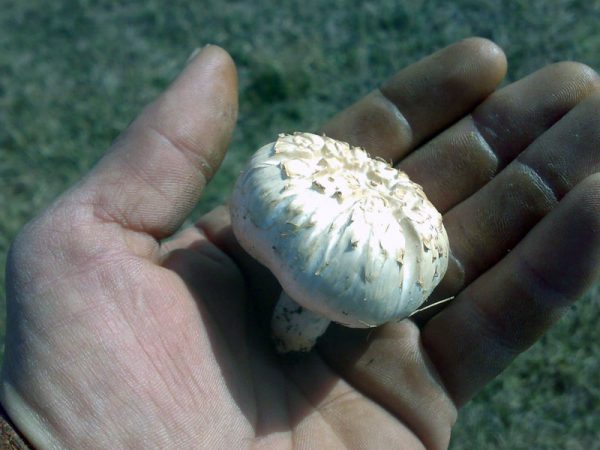

Two-ring champignons have dense, resilient and large caps
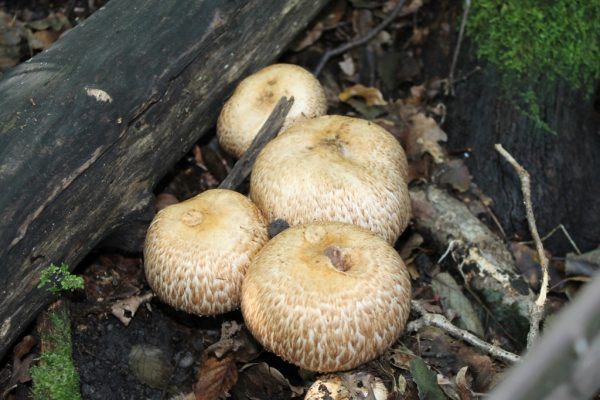

Nodule champignons can be distinguished by their beige skin tone
Do I need to peel the mushrooms before cooking or do it in advance
More often it does not depend on the recipe, but on the state of the mushrooms. The standard recommendations for the choice of products require in most cases to use only the freshest mushrooms. What to do with mushrooms that have been in the refrigerator for several days?
First of all, make sure they are still edible.The mushrooms covered with dark spots should certainly be cut off, without even understanding the reason for the origin of such damage. Once you start cutting off the darkened parts, notice how easily the top layer of the skin peels off. It may be worth removing it completely, as peeling champignon mushrooms is not much more difficult than just cutting off the damaged parts.
It is known from practice that peeled mushrooms cannot be stored for a long time, even in the refrigerator. Mushrooms packed in an airtight bag or covered with cling film can lie in the usual compartment of the refrigerator, without spoiling or losing their taste, no more than a day. Take this into account before peeling the mushrooms, fresh mushrooms are stored noticeably longer before washing and peeling off the skin, up to three days in a package.
Storage features
If it is not possible to cook mushrooms right away, it is not possible to place the sliced workpiece in a plastic container or glassware with low sides. You can store mushrooms in this way for no more than a day.... In this case, the product should be tightly closed with a lid or wrapped in cling film. This will help prevent browning of the mushrooms.
Important! If you add a couple of drops of lemon juice to the peeled mushrooms, they will not darken during storage and will retain their freshness!
Do not add mushrooms to the dish if they become moldy during storage. You can understand that the mushrooms have gone bad by the soft, slippery leg or hat... Do not try to reanimate them, but discard such mushrooms immediately. Do not keep peeled mushrooms in the refrigerator for too long. Before cooking with standing mushrooms, it is imperative to shorten the leg by 2 mm.
No matter how many recipes for mushroom dishes exist, none of them can be done without cleaning and processing mushrooms. How to prepare correctly before cooking, you now know.
Do I need to peel the mushrooms before frying
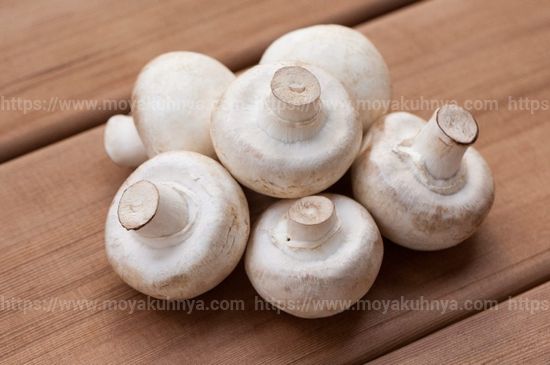

Be sure to do this if the mushrooms have been bought or harvested for a long time and they will end up in the pan after prolonged storage. A darkened skin on the caps is a sign of a natural decrease in the amount of moisture in mushrooms; when heated, it often shrivels, separating from the rest of the pulp. It is unlikely that the dish in this form will look appetizing and the question of whether it is necessary to clean the mushrooms fresh from the store before frying should be resolved positively.
If, before sautéing or frying, the mushrooms need to be finely chopped, and the skin on them is relatively light, the cutting process can be neglected. Exclusively fried mushrooms are rarely served, mainly moisture is first evaporated from them, then slices or whole mushrooms are browned and finally stewed with onions or pouring water (broth).
Frying mushrooms in deep fat more often than other types of heat treatment leads to the separation of the skin. There is no other way to avoid this, other than peeling the mushrooms for frying in boiling fat. Moreover, it is worth doing this even if your mushrooms are rather small.
One of the popular dishes is fried potatoes with mushrooms. Champignons in it, as a rule, are first slightly blanched, cut into thin slices and sautéed separately from the potatoes. If you wish to remove the skin from the mushrooms in this case, do so before slicing.
The recommended sequence of actions is as follows:
- Soak the champignons, rinse and dry.
- Boil for about 3 minutes in salted boiling water and cool.
- Remove the skin from the leg with the cap, and then cut the mushrooms into slices.
- Evaporate the moisture from the chopped champignons in a dry frying pan and temporarily transfer the mushrooms to a bowl.
- Strongly heating a small amount of oil, at the maximum temperature, bring the mushroom slices to an amber color.
We have considered the general points of the question.It is worth mentioning in conclusion that the absence of specific instructions for cleaning mushrooms in recipes leaves it at your discretion. Focus on the quality of the product and remove all damage for the sake of safety, and remove the entire skin just in order to get a more tender dish.


Delicious and healthy mushrooms are popular among professional chefs and housewives. Clean and tidy mushrooms are eaten even raw. But you should still peel and process the mushrooms before further cooking. And it is important to do it correctly.
Royal mushrooms in sour cream sauce
Cooking method
1
We peel the onion, rinse, dry. Cut into small cubes.
2
Soak the mushrooms in cold water and dry. Cut the mushrooms into slices of medium thickness.
3
Heat the refined oil in a large frying pan, throw in the chopped onion, caramelize for 5 minutes on high heat.
4
Pour in the cooked mushrooms, return the pan to medium heat, fry for 3 minutes.
5
We introduce a measured amount of sour cream, if desired, replace it with cream, increasing them in volume (milliliters).
Add dark pepper, salt, chopped young garlic. Stir all the components of the pan, cook for another minutes under the lid.
6
We decorate the dish with the freshest herbs, serve with a side dish - steamed rice, buckwheat, mashed potatoes. Bon Appetit!
Is it necessary to peel mushrooms before cooking
It is not safe to cook freshly acquired mushrooms right away. Their fruiting bodies must at least be wiped with a damp cloth.
It is imperative to clean it, I suppose it is necessary to wash it too ... Shop mushrooms are grown not just on the ground, but on a well-fertilized substrate, and believe me, there are enough nitrates.
Shramko Tatiana
Mushrooms were grown in artificial conditions, but the substrate is not sterile. Therefore, it is also safer to rinse the mushrooms under running water. Young small specimens do not need any other processing.
Forest mushrooms cannot be called pure. From the fruit bodies, remove the remnants of the earth with a brush, rinse and cut off the lower part of the legs. Since the skin of young mushrooms is delicate and thin, it is pointless to remove it.
Little tricks when cooking champignons
- It is permissible to store peeled mushrooms in the refrigerator, but only for 24 hours with the obligatory subsequent trimming of the stem.
- Peeled mushrooms can be sprinkled with fresh lemon juice, then covered with plastic wrap - this way they will preserve freshness longer, and put in the refrigerator.
- You should not remove the skin from young, fresh and small fungi - it is she who gives the dish a special aroma and taste.
- When preparing forest mushrooms for food, do not avoid soaking them in water in order to remove adhering earth and foliage.
- It is best to clean this food exactly before cooking, as it tastes better.
- Do not keep fresh, store-bought mushrooms in water for a long time, otherwise they will become tasteless.
- In order for the taste of champignons to reveal more fully, you need to cut them into pieces or use the smallest specimens for cooking.
How to properly clean mushrooms
A sharp knife, a colander, a clean sponge and a cutting board, a container, and flour are prepared to process the "catch".
What you need to clean mushrooms
A sharp knife is required. Professionals advise choosing a tool with a thin long blade. It is convenient for them to clean the caps from the inside.
You can replace the kitchen sponge with a soft cloth.
The container is deep and wide recommended. It is more convenient to handle mushrooms in it.
How to properly clean mushrooms
They start with sorting. The spoiled mushrooms are thrown away.
If there is rot - no circumcision, just throw it away!
To prepare any dish with champignons, they are cleaned of debris. Professionals advise to first clean the fruit bodies of sand, soil particles with your hands.
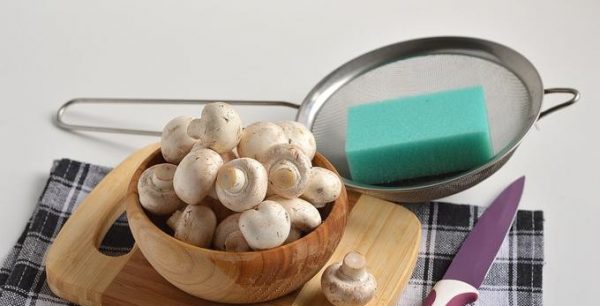

A cutting board, a knife, a colander, and a kitchen sponge are prepared for cleaning mushrooms.
To destroy harmful organisms developing in the fruit bodies, mushrooms are placed in an oven heated to 80C for one and a half minutes.
The champignons are examined by removing the windy, wilted places and cleaning off the dirt with a sponge.
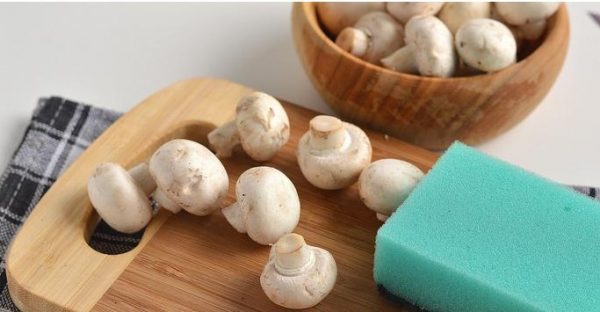

Mushrooms are sorted, cleaned with a sponge
Cut off the bottom of the leg with a knife, refreshing the cut. The longer the mushrooms have been in the refrigerator, the more it is recommended to trim the fruit body.
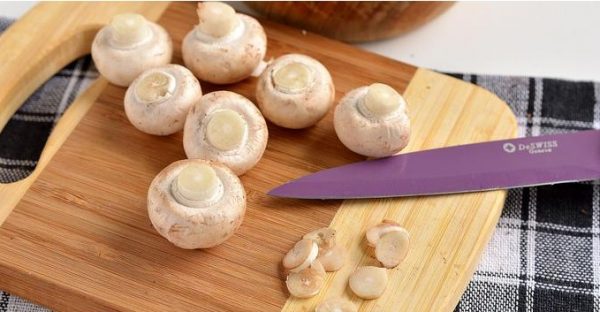

Champignons refresh the place of the cut on the stem
If you wish, you can remove the skirt and skin from the cap, but this is not necessary.


If you wish, you can remove the film under the cap
A thin cuticle is picked up at the edge of the cap, pulled upwards. But this is optional.
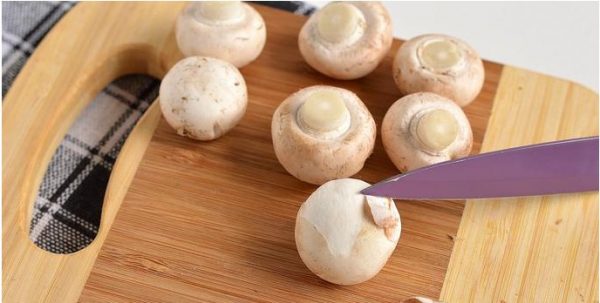

Peel off the mushroom cap with a knife
The mushrooms are quickly washed, no longer than 5 seconds, with cold water, the moisture is shaken off.
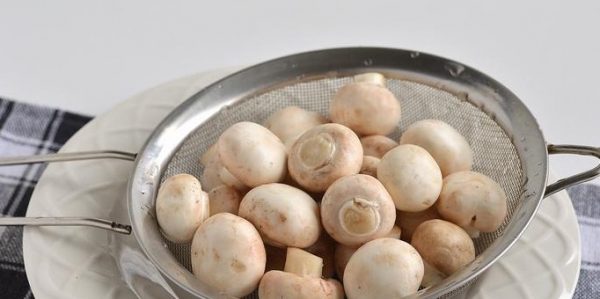

Mushrooms are washed under running water
Prepared mushrooms are laid out on paper towels to remove excess moisture. The less mushrooms are in the water, the better their taste.
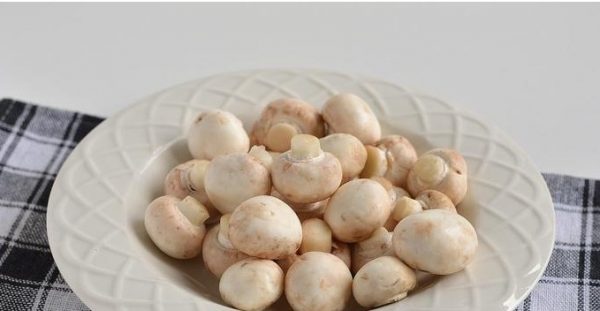

Mushrooms are ready for further processing after drying.
Let's start cleaning with a knife
- First you need to cut off the rot, damaged and withering places, if any. Severely spoiled mushrooms should be discarded.
- Then you need to cut off the bases of the legs, which may be dry or stained in the ground.
- It is enough to cut 2 mm. If the mushroom is large or old, remove the skin from the cap of the mushroom with a knife, starting from the edge to the center. In such mushrooms, the skin, as a rule, is dense and can be removed quite easily. If left on, it can soften poorly during cooking and ruin the dish.
- Whether to remove the skirt at the base of the mushroom and the dark plates under the cap is up to you. They are edible and do not affect the taste of the mushroom. However, some housewives get rid of them for aesthetic reasons. Especially if the mushrooms are served raw.
Young mushrooms do not need to be thoroughly cleaned!
Now for the good news! Most mushrooms do not need to be peeled with a knife. If the mushrooms are young, fresh, white, small in size, it is not at all necessary to clean their caps from the skin, because they are already very delicate. It is enough to rinse with water, scrape off the dirt and renew the cut. Therefore, try to choose just such mushrooms.
Remember that processed mushrooms are stored in the refrigerator for no more than a day.
Peeled and thoroughly dried mushrooms can be frozen in the freezer, where they are stored for up to a year. If you are going to serve the mushrooms raw, then it is worth subjecting them to a more thorough cleaning and pouring over boiling water. Then you will definitely eliminate the risk of poisoning.
For better storage, the mushrooms are cut into thin bars and blanched in hot water.
Unlike small young mushrooms, large specimens must be cleaned. During ripening, the skin on the champignon cap becomes denser. That is why it should be removed, after which you can start cooking.
Important! The peel of all sizes of mushrooms stays thin and does not need to be peeled. You can separate the legs from the caps - this sorting will help reduce the time for preparing the mushrooms.
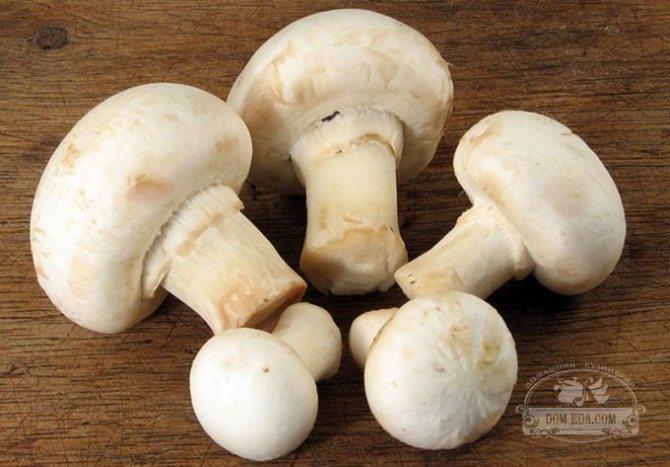

Cleansing Secrets from Experienced Culinary Experts
If, when washing, the skin is effortlessly pushed back with the pad of the finger, then the skin is removed to the end.
How to quickly peel mushrooms - video
To remove the cuticle from large mushrooms, the edge of the cap is broken, prying a piece with a knife, and the skin is pulled up. The actions are repeated along the entire cap.
- The cuticle is easier to remove if the cap is scalded.
- The mushrooms stored in the refrigerator are cut off the legs higher in order to remove all problem areas.
- After washing the mushrooms, the mushrooms are immediately dried. It is impossible to leave champignons in liquid for a long time.
More often not mine. I clean the top film of the cap with a knife and, if the legs are large, I also clean them.I use the legs for broths, I don't cook them. And I take out the mushroom plates with a spoon, I don't cook with them. If you want to put it raw in a snack, I blanch it for a couple of minutes and on ice, well, that’s it, to cleanse external irritants.
HELEN C.G.
Champignons are recognized as the safest mushrooms. However, for complete confidence in the safety of food, it is important to prepare them for further processing correctly.
If there are no questions about the mushrooms collected with your own hands in the forest - they must be washed and cleaned of needles, blades of grass, small insects and soil, then the question remains open with the store ones. They look so clean and fresh that the question naturally arises - do they need to be washed and cleaned?
How to store, freeze
The rules for storing champignons require mandatory compliance: mushrooms are a perishable product.
Important If the mushrooms are fresh, but their preparation is planned for tomorrow or the day after tomorrow, then do not wash or peel them! Just place the food bag on the bottom shelf of the refrigerator.
Basic storage rules:
- The first thing to learn about champignons: any manipulations are carried out immediately before cooking.
- Do not tie a plastic bag to prevent moisture from accumulating in mushrooms.
- The maximum shelf life in the refrigerator is a week. Keep the temperature in the chamber within 2-4 degrees.


Long-term storage in the freezer is also possible. How to start freezing a product:
- It is enough to wipe them with a damp cloth and clean them according to all the rules.
- You can cut the mushrooms into slices and sprinkle with lemon juice for better preservation.
- It is better to place the product in a plastic wrap.
And one last thing: how to make a delicious frozen mushroom dish? Defrosting should not be carried out completely, otherwise the mushrooms will darken and become limp.
Cook the mushrooms correctly, and then they will not disappoint you. It is a very aromatic, soft-tasting and healthy product.
Why peel and wash mushrooms?
Regardless of where the mushroom was found - in the forest or on store shelves, it must be washed under running water. Why? In addition to natural debris, insects and pests can live in forest "inhabitants". Mushrooms grown in artificial conditions differ from their natural counterparts in the purity of their caps and legs, but they also grow in a substrate that is far from sterile. Various microscopic organisms can live on them. Don't forget about dust, it is everywhere. In addition, while the mushrooms make their way from the garden to the stalls, they will pass through the numerous hands of workers.
Store young specimens should be rinsed well under water. It is not enough to wash the mushrooms collected in the forest, they must be additionally cleaned of earth, insects and other debris and the top layer, which may contain harmful, toxic substances, is removed. The fungus absorbs them from the environment.
Is it possible to determine the origin, quality and freshness of mushrooms when buying them
When buying a product in a store or on the market, a potential buyer should pay attention to a number of important nuances:
- The presence of a film between the leg and the cap. Fresh champignon has it white, firm, dense.
- Dryness of the cap. The mushroom should be dry and smooth to the touch. If it sticks even a little, then it is not recommended to make a purchase.
- Small spots. The champignon should be white or with a slight shade of beige and gray. Fresh fruit has no wormholes, holes, spots.
If a mushroom does not meet any of the listed characteristics, then this does not mean that it is spoiled, but the shelf life is coming to an end. This means that it should be consumed on the day of purchase, there is no point in storing it further.


Fresh and high-quality mushrooms will be perfectly white, matte, smooth and slightly velvety to the touch
The origin of the mushrooms is very easy to determine. Even if they are sold not in the store, but in the market, most likely they are grown in greenhouse conditions.Forest or meadows are extremely rare, visually they are completely different.
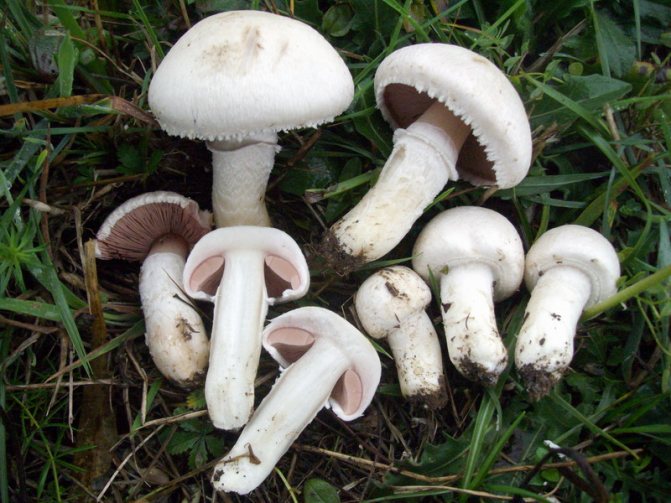

Forest mushrooms look very much like toadstools.
There are other subspecies of champignons, which also differ from the usual ones. For example, August, garden, dark red and others.
Do I need to soak mushrooms?
These mushrooms not only contain a large amount of water, but also, due to their structure, absorb it very quickly, which reduces the shelf life of the product and negatively affects the taste. therefore keep them in water for a long time, and even more so they do not need to be soaked before heat treatment... The younger and stronger the mushroom, the longer it can undergo "water procedures" without loss of quality. This applies to a store product.
After washing, experts recommend blotting them with paper towels and drying them additionally for 15 minutes on a regular dry towel, this will help to quickly remove excess moisture and prevent them from softening.
Forest mushrooms are soaked for a very short time in a concentrated saline cold solution - 15 minutes is enough for insects or pests hiding inside the mushroom body to crawl out of them. And also the procedure will facilitate easier removal of dirt.
The first step is to rinse in water
As a rule, we buy champignons in supermarkets or in markets where we are offered cultivated mushrooms that are grown on farms, greenhouses or greenhouses. This means that they do not have strong pollution from the ground, moss, sand.
However, no matter how clean they may seem, they are not grown under sterile conditions. Therefore, first of all, the mushrooms must be thoroughly rinsed in cold running water. We don't want dirt to creak on our teeth and fertilizers get into our stomachs, do we? By the way, for this purpose, you can use the rough side of the dishwashing sponge. Hopefully it’s not worth explaining why the sponge should be new?
But it is not recommended to soak mushrooms in a bowl of water, since they absorb moisture very quickly, which can negatively affect their taste.
Experienced housewives know that such mushrooms will hardly taste like mushrooms. After rinsing, spread the mushrooms on a paper or kitchen towel to quickly absorb excess moisture.


Preparing mushrooms before harvesting
The preparation of mushrooms is carried out in different ways. It depends on which heat treatment method is chosen.
How to properly peel mushrooms is shown in the following video:
Frying
Do not wash the mushrooms before frying, otherwise they will absorb excess water. They are cleaned with a brush, wiped with a damp cloth, and damaged and darkened areas are removed. Mushrooms processed in this way are obtained with a beautiful golden crust and crispy.
Cooking
Mushrooms are well washed under running water, and the leg is cut. Flaws are not removed, since they will be invisible in the dish.
Baking
For baking, large caps are usually used, from which all plates are removed. They are satisfied with short water procedures, adding 1-2 tbsp to the water. l. wheat flour. It acts as an abrasive substance that helps to mechanically clean the caps from the "skin".
Freezing
For such processing, fresh mushrooms are used, all darkened parts are cut off from them. Then they are washed and dried. It is better to immediately cut the mushrooms into slices, sprinkle them with lemon juice, and wrap them in cling film. In this form, they are sent to the freezer. If the frozen product is used for making soup or stewing, then you do not need to defrost it. Complete defrosting negatively affects the appearance of the mushrooms. They lose their structure and darken.
Drying
Mushrooms must not be washed before drying, otherwise they will darken, and the drying time will noticeably increase, which is fraught with the development of various molds on the surface. Before cooking, dried mushrooms are soaked in water. This is enough to remove dust from them.Therefore, only high-quality specimens are selected for drying, without damage.
Fresh mushrooms
Real gourmets prefer to eat raw mushrooms. Quality mushrooms are harmless to human health. Before use, they are thoroughly washed, dried well and all damaged and darkened places are cut off. To destroy all pathogenic microorganisms on the product, it is sent to a heated oven or oven for a few seconds.
In addition to washing, some mushrooms require cleaning. The most convenient way to do this is to take a knife with a sharp, thin blade, which is convenient for cleaning the caps from the inside. You will also need a brush and wet wipes.
How to prepare mushrooms for further cooking (roasting, boiling, drying, freezing)
| Type of mushroom processing | Preparation technology |
| Frying |
|
| Cooking |
|
| Raw food |
|
| Drying |
|
| Freezing |
|
It is worth noting that different methods of preparing mushrooms involve different types of cutting of this product:
- cubes: separate the legs, cut into equal squares. The best option for cooking with potatoes, caviar or ordinary frying;
- straws: this way you can cut the mushrooms before cooking salads;
- slices: A great way to slice mushrooms quickly before frying.
Important rules
To properly prepare mushrooms, adhere to the following rules:
- Cleaning mushrooms always starts with sorting them. In the process, all spoiled specimens are thrown away, as well as mushrooms with areas of rot.
- Be sure to trim the legs - regardless of where they were grown. When collected in greenhouses, they are cut off and put directly into a bucket. As a result, dirt gets inside the leg. Gathering champignons in the forest, experienced mushroom pickers turn them out of the mycelium, so the remains of mycelium and soil remain on the legs. When pruning, the legs adhere to the rules - the longer the mushroom has been stored, the more of the legs are cut off.
- The spoiled places are cut off. The darkened areas on the leg are carefully scraped off with a knife. Only healthy parts of the mushroom are eaten.
Forest mushrooms are quite fragile and pretreatment can compromise their integrity, in order to increase their density, before cleaning, they must be placed in warm water for 20 minutes, then removed and subjected to the necessary procedure.
Methods for cleaning champignon
The process of mushroom cleaning depends on the age of the mushroom and the place of its growth.
Button
The cap of such mushrooms does not exceed 2 cm in diameter. It is covered with a very thin skin and does not need to be cleaned. Preparing young mushrooms will not take long. It is enough to brush off the remains of soil or substrate from them and rinse well in running water. Their legs are so small that they are barely visible from under the cap, they are cut.
Old or large champignon
These mushrooms differ from their young counterparts in the size of the cap, it usually exceeds 5 cm in diameter and is covered with a dense skin. During heat treatment, it does not soften, therefore, so that it is not felt in the dish, it is first removed. They do it as follows:
- First, brush off the adhering dirt with a brush.
- Then, with a sharp knife, remove the "skin", gently picking up the edge of the cap and pulling it to its middle.
- Refresh the cut of the leg. If the mushroom has been in the refrigerator for several days, then the entire dried part is cut off, since it will be felt in the dish.Cooks legs with a hardened "skin" are completely removed.
- Mature mushrooms open up, and "skirts" are formed on their legs. They do not affect the taste in any way, but some people think that they look ugly and they are removed.
- Plates under the cap - and the older the mushroom, the more saturated brown they become, you can also clean it. But remember that it is they that give the dish the mushroom aroma and flavor.
Cleaning mushrooms in the forest
Fans of "quiet hunting" clean mushrooms right in the forest. The plucked mushroom is cleaned of natural debris and soil with the help of a non-hard food brush. Gently, with scrubbing movements without pressure, dirt is removed from them and sorted. Forest mushrooms are stored in the refrigerator for no more than 5 days.
Shop mushroom
There are usually no problems with these mushrooms. They have already gone through the initial cleaning and grading. They are washed, the legs are cut again, the spoiled areas are cut off. Depending on age, the skin is removed from the caps and legs. Purchased mushrooms are not stored, but immediately put into "business" on the first day after purchase.
A quick way to clean up from the experts
Professional chefs have secrets to quickly peel mushrooms:
- so that all the dirt instantly comes off the mushroom, experts recommend soaking them for 20 minutes in hot water;
- large caps are easy to clean from the "skin" using coarse-grained emery paper, but it will often have to be washed in water, since it quickly "clogs up";
- if you scald the mushroom with boiling water, the skin is easily removed by hand.
Rules for cleaning fresh mushrooms
Based on the size of the mushrooms, their age and the recipe according to which the dish will be prepared, different cleaning methods are used. For this, as a rule, a washcloth, knife, grater, brush is used.
Basic rules for cleaning champignons:
- It is not recommended to soak these mushrooms for a long time, as they are able to quickly absorb liquid. This significantly impairs the taste of the product as well as its odor. In addition, it will take a long time to evaporate liquid from water mushrooms.
- Do I need to clean fresh mushrooms from the ground? Yes, this is a must, and the leg is trimmed like any mushroom, greenhouse and forest. Gathering champignons in the forest, they are torn off or cut off with a knife from the mycelium. As a result, there will certainly be earth on the legs, which will then need to be cleaned. If the mushrooms have been cut, then they are placed in a bucket and continue to be harvested. This leads to the adhesion of dust and dirt to the cut, which are then absorbed into the leg.
- Darkened or damaged places are necessarily cut off, since they do not bring anything but harm to health. If there is a small speck on the stem of the champignon, it is permissible to carefully remove it with a knife.
- The "skirt" located at the top of the leg (several types of champignons have it) can be left as it can be eaten. If desired, it is removed from the mushroom. In this case, it is not necessary to cut out part of the leg together with the "skirt".
Attention! Peeling champignons that differ in size has some differences, as large mushrooms have a harder and coarser skin.
To clean mushrooms, regardless of size, you will need:
- a small knife, as it is more convenient;
- a vegetable brush (if desired, it can be replaced with an iron scourer for cleaning dishes);
- a container into which pure mushrooms will be placed;
- wipes or a towel that absorbs moisture well (desirable). This is necessary to remove excess water that can be absorbed into the mushrooms;
- colander - needed to rinse the mushrooms and wait until the water is completely drained.
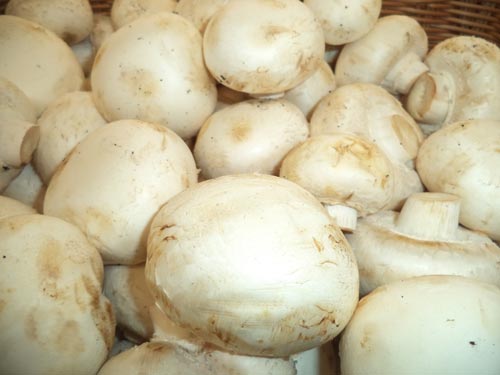

Champignons before cleaning
Testimonials
Each housewife adheres to her own opinion in the matter of cleaning and washing champignons. Some people absolutely do not accept washing mushrooms, while others, on the contrary, thoroughly wash them out.
So, although champignons are recognized as the safest mushrooms, they are recommended to be washed.Clean in appearance, they may contain microorganisms and chemicals. Therefore, it is important to adhere to the basic rules for washing and cleaning mushrooms, and only after careful preparatory work, start cooking.
About the beneficial properties of champignons
Champignons are composed of carbohydrates, fats, organic acids, minerals and a complex of vitamins. Due to their low calorie content, they can be used in many diets without depriving the body of essential nutrients.
Champignons also contain special substances that destroy cholesterol plaques, reduce the risk of heart attack and prevent atherosclerosis.
These mushrooms are also suitable for diabetics.
But it is worth considering that champignons contain chitin, which is difficult to digest. Therefore, it is not recommended to give them to children under 7 years of age.
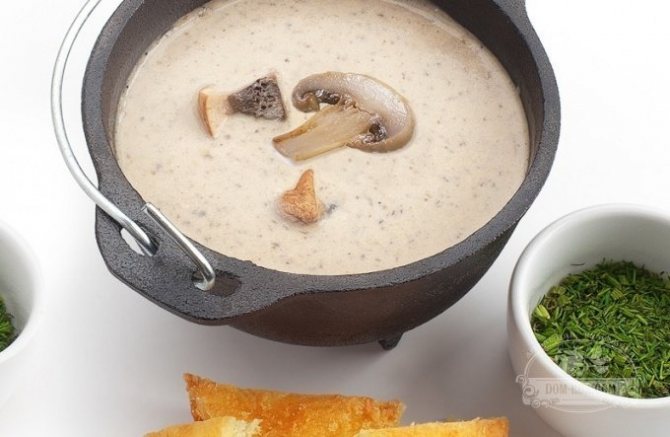

There are no special requirements and rules for the preparation and cleaning of mushrooms. However, every hostess should know that the taste of the finished dish will depend on how the mushrooms were prepared.
While almost no one disagrees with the question of cleaning mushrooms collected in nature, they constantly argue about champignons. Some argue that greenhouse mushrooms do not need such a procedure, others cannot be convinced that this approach is safe. Let's evaluate all the pros and cons and find the optimal solution for the most typical situations.

